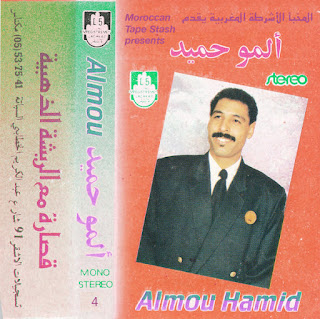A Gnawa offering to round out the strange year that was 2021. Here's a lovely album from Mokhtar & Zaida Gania. Mokhtar and Zaida are the brother and sister of the late mâalems Mahmoud and Abdellah Gania, and I believe they are the last surviving children of Mâalem Boubker Gania.
Zaida is a mqaddma ritual leader in Gnawa ceremonial life, and of course grew up in a family of Gnawa musicians and ritual practitioners. In addition to performing music with her male Gnawi family members, she also leads all-female haddarat percussion groups:
Mâalem Mokhtar has performed in traditional and fusion Gnawa settings. His singing voice is deeper and more resonant than that of his late brother Mahmoud. And he plays this badass guinbri:
The tracks of this album feature an appealing variety of textures. Gnawa music in its traditional form stays pretty uniform in terms of texture (a guinbri, some qarqabas, and some male call/response vocals). It's a great texture, and sometimes that's exactly what the doctor ordered. But sometimes it's nice to change things up too. On this album you get: songs with added percussion (A2, and especially B5), songs with Zaida singing lead (A1, B1, B2, B5) or along with the male chorus (A1, A3, A5, B4), and songs with a tenor sax (A4, B2).
Female and male voices together in Gnawa music don't always work for me, but in this instance the combination sounds great - perhaps the fact that it's family makes the blend organic. Men and women of the Gania family can also be heard singing together on Maâlem Mahmoud's 1994 album with Pharoah Sanders The Trance of Seven Colors, and the blend there is likewise wonderful.
The use of tenor sax on this album also hearkens to The Trance of Seven Colors. In fact, it's the only other recording I can think of that features a full Gnawa group augmented only by a saxophone. Typically when you hear a saxophone with Gnawa, you are also hearing other instruments like a drum kit, keyboards, guitars and other percussion. I wish I knew who was playing the sax here - the approach is nice, and somewhat reminscent of the way Pharoah played with Mahmoud's group.
Mokhtar remains active as one of the elders of Gnawa music in Essaouira. His performance with his nephew Houssam was one of many highlights of the huge Gnawa concert that was broadcast on Christmas day on Moroccan TV. The concert, which was filmed in Essaouira, featured dozens of Gnawa mâalems and koyos from across Morocco. You can watch the entire show, which was very good, on YouTube:
Thanks to all of you who continue to visit Moroccan Tape Stash after all these years. May 2022 bring goodness and joy to you all, and may humans across the planet join hearts, hands, and minds in love and mutual respect to confront the formidable challenges we continue to face.
El Moukhtar & Zaida Kania المختار و زايدة كانية
Azza Production AP-03/03
2003
A1 Tsarkou Wallah Kobayni تسركو والله كوبايني
A2 Foufou Danba فوفو دنبا
A3 Jabriyi جابريي
Moulandi مولاندي
A4 Jankriyi خانكريي
A5 Barkiou باركيو
Kobayli Bralf كوبايلي برالف
B1 Yallah Foulane Essaadi يالله فولان السعدي
B2 Yallah Yamani يالله يماني
B3 Sidi Sma Samaoui
B4 Allah Allah Samaoui الله الله السماوي
B5 Allah Allah Moulana الله الله مولانا



















